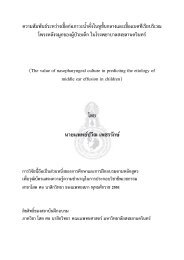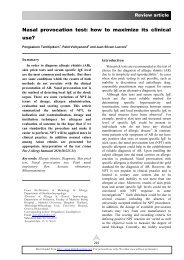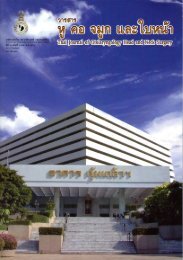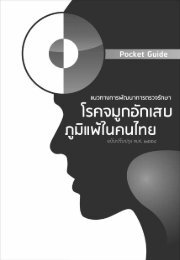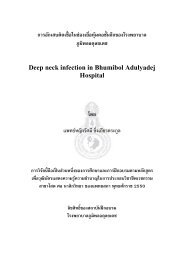Download File - ราà¸à¸§à¸´à¸à¸¢à¸²à¸¥à¸±à¸¢ à¹à¸ªà¸ ศภà¸à¸²à¸ªà¸´à¸à¹à¸à¸à¸¢à¹ à¹à¸«à¹à¸à¸à¸£à¸°à¹à¸à¸¨à¹à¸à¸¢
Download File - ราà¸à¸§à¸´à¸à¸¢à¸²à¸¥à¸±à¸¢ à¹à¸ªà¸ ศภà¸à¸²à¸ªà¸´à¸à¹à¸à¸à¸¢à¹ à¹à¸«à¹à¸à¸à¸£à¸°à¹à¸à¸¨à¹à¸à¸¢
Download File - ราà¸à¸§à¸´à¸à¸¢à¸²à¸¥à¸±à¸¢ à¹à¸ªà¸ ศภà¸à¸²à¸ªà¸´à¸à¹à¸à¸à¸¢à¹ à¹à¸«à¹à¸à¸à¸£à¸°à¹à¸à¸¨à¹à¸à¸¢
Create successful ePaper yourself
Turn your PDF publications into a flip-book with our unique Google optimized e-Paper software.
34วารสาร หู คอ จมูก และ ใบหน้าปีที่ 10 ฉบับที่ 3 ก.ค. - ก.ย. 2552Magnetic resonance imaging of brain revealed extension left otomastoiditis with local involvementof adjacent structures including left petrous apex, Meckel’s cave, carotid space, left occipital condyle,left cranial nerve VII and VIII, external acoustic canal, pinna and temporalis muscle with corticaldisruption of left temporal fossa associated with dural enhancement. Numerous small hyposignalT 1, hypersignal T 2with ring and nodular enhancement. Scattering in both cerebellum, cerebral hemisphereand brain stem compatible with leptomeningeal spread of left otomastoiditis.Diagnosis of this case was left tuberculous otitis media with complication and disseminated TB.Comorbid diseases were non-insulin-dependent diabetes mellitus and gouty arthritis.This patient was treated with antituberculosis treatment (2RHEZ/7RHE). Subsequent follow-upsafter 3 months showed marked improvement of symptoms, healing of external acoustic canal lesionsand tympanic membrane perforation.DiscussionTuberculous otitis media had been reported in all age groups but occurred most commonly inchildren, about 50 percent. Half of these patients presented with long duration of painless otorrhea.Physical examination revealed abundant pale granulation tissue that may mislead to the diagnosis ofcholesteatoma and mastoidectomy was performed due to misdiagnosis.The etiology of spreading to middle ear was described by entering through the eustachiantube 6 . In the other hand, hematogenous spread has been described in cases with military tuberculosis 7as in this case.The role of surgery has been changed due to the advent of specific chemotherapy. In thepast, the surgery was done to provide drainage, to control spreading to central nervous system and torelieve facial paralysis. Nowadays, the indication of surgery is for decompression of the facial nerveand for removal of necrotic tissue which might remain after administration of antituberculosis drug.In this case, we treat the patient with antituberculous drug. The patient recover well. We didnot perform facial nerve decompression in this case because he had prolonged complete facial nerveparalysis for more than 2 months. If we perform the operation , the procedure may not only have nobenefit but also be harmful to the nerve.Tuberculous otitis media is an uncommon disease that can cause severe damage to the middleear and surrounding structures. The clinician should aware of clinical signs and symptoms with highlevel of suspicion in order to early diagnose this condition. The underlying condition, pulmonary andintracranial TB lesions including chronic otorrhea with granulation this we may lead to this condition.Treatment is primarily by antituberculous drugs.



